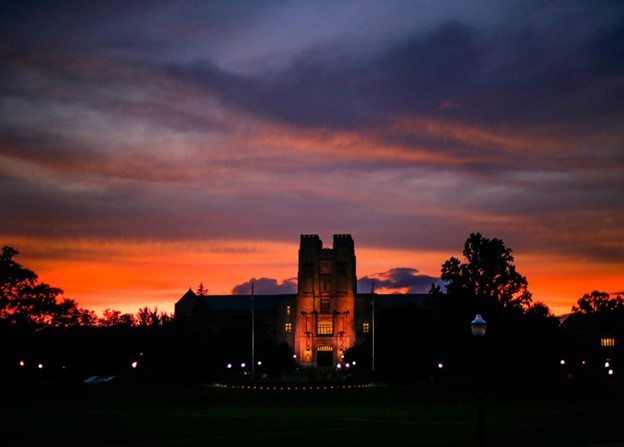Choosing a university isn’t easy. It may not be the most important choice you’ll ever have to make, but it’s up there. Even more so if you’ve worked hard and know that most schools would love to have you as their student. But knowing what your academic interests are and what program you’d like to apply for helps. If it’s something that has to do with technology, start looking for the right university for you with the highest-rated tech schools in the country. Here are some of the best among them.
#1 Massachusetts Institute of Technology

Source: MIT
Massachusetts Institute of Technology (MIT) needs no introductions. It’s the first university most people think of when asked about the top tech school in the world, not to mention the U.S. Some of the leaders of the technology industry, as well as researchers behind the greatest technological innovations, are MIT alumni (or even students). For example, the 1965 Nobel Prize in Physics laureate, Richard Feynman, was an MIT graduate. And so are Ilene S. Gordon, a former CEO of Ingredion, and Jonah Peretti, the co-founder of BuzzFeed.
Located in Cambridge, MA, MIT’s campus is quite small (at least compared to some other top universities in the U.S.), but it’s home to many great programs. MIT’s Bachelor’s programs include Computer Science, Mathematics, Engineering, Econometrics and Quantitative Economics, and Mechanical Engineering, among many others. Some of the Master’s programs available there are Chemical Engineering, Nuclear Science and Engineering, and Civil and Environmental Engineering. An MIT applicant with basically any tech-related academic interests is guaranteed to find a program that will match them.
MIT is notoriously difficult to get in, but the career opportunities open to its graduates are well worth the hard work. Anyone who dreams of revolutionizing the technology industry or becoming the CEO of the next Google or Tesla should at least try to become an MIT student. What’s more, MIT is celebrated for the inclusion-promoting efforts of its Admissions Committee. It’s one of the few tech schools in the U.S. where the number of female students is almost 50%, and members of minority populations hold over one-half of all seats.
#2 Georgia Institute of Technology

Source: Georgia Tech
Georgia Institute of Technology (Georgia Tech) is another school that holds top places in the rankings of top tech universities in the U.S. every year. It might be the alma mater of many MIT rejects, but that doesn’t mean that Georgia Tech has no famous alumni to be proud of. Jimmy Carter, the 39th president of the U.S., Dean Kamen, the inventor of Segway, and Alexandra Elbakyan, the creator of Sci-Hub, are all Georgia Tech graduates.
Similarly to MIT, Georgia Tech has a lot of Bachelor’s and Master’s programs, most of which are obviously tech-focused. It also has an impressive list of minors. They include Aerospace Engineering, Architecture, and Global Development (among countless others). So if you’re struggling with choice overload or would like to pursue two knowledge areas at the same time, Georgia Tech is a good place to consider. Just keep in mind that studying at one of the top tech schools in the country isn’t easy. So make sure not to bite off more than you can chew.
Georgia Tech is much bigger than MIT, which is one of the reasons why its admissions rate is also way higher (16% against 4%). This number may still seem intimidating, but it doesn’t really mean much. Georgia Tech has a stellar reputation in the tech industry and among students who’d like to study something technology-related. So it’s on everyone’s radar. As a result, people are applying without thinking if they have any chance of getting in. The admissions rate among those who are actually competitive (have a high GPA, relevant achievements, and a bunch of extracurriculars to match) is way, way higher.
#3 Statistical and Applied Mathematical Sciences Institute

Source: SAMSI<
Statistical and Applied Mathematical Sciences Institute (SAMSI) may not be as famous as other universities on this list. But it definitely deserves the title of one of the top tech schools in the country. Established in 2002, SAMSI is young. Nonetheless, it unites the expertise and experience of several established institutions. They are Duke University, North Carolina State University, and the University of North Carolina at Chapel Hill.
SAMSI is primarily a research university, which is reflected in its vision statement. It invites visiting researchers from across the U.S. to join efforts with SAMSI’s own bright minds and advance science. Unlike most other technology universities, SAMSI has a quite well-defined focus. The research carried out at SAMSI, as well as most of its student programs, have to do with statistical and applied mathematical sciences. Thanks to such a narrow subject area, the SAMSI helps its students and researchers explore their academic interests with no distractions.
SAMSI is a research university that aspires to stay up to date with all science and technology trends. That’s why it updates its research programs every year. The most recent ones included Numerical Analysis in Data Science, Combinatorial Probability, and Data Science in the Social and Behavioral Sciences. As the latter suggests, SAMSI embraces interdisciplinary research.
Unfortunately, SAMSI closed its doors in the summer of 2021. But its mission and vision live on through the researchers who got to carry out their studies at SAMSI.
#4 California Institute of Technology

Source: Caltech
California Institute of Technology (Caltech) is also a research university, but the list of the research areas (as well as student programs) it covers is much broader. It’s a great place for students and researchers interested in any aspect of science, engineering, and technology. By the way, Caltech manages the Jet Propulsion Laboratory (JPL) for NASA, helping NASA explore the mysteries of the solar system. One of JPL’s best-known missions is Mars 2020. Impressive, right?
If you’re thinking of applying for a degree at Caltech, you have a lot of options. Similarly to MIT or Georgia Tech, Caltech has no shortage of academic programs at both the undergraduate and graduate levels. You can pursue a Bachelor’s in Computer Science, Mechanical Engineering, Chemistry, Astrophysics, Neuroscience, and whatnot. The list of graduate programs is not much shorter and includes a few rare options, for example, Aeronautics.
By the way, if you think that MIT has the lowest admission rate because of how in demand it is among students interested in tech, you’re wrong. Caltech’s admission rate is actually 0.2 points lower than MIT’s. But thanks to such a rigorous vetting process, both schools have great graduation rates of over 90%. If Caltech is your dream school, don’t let the competition discourage you. The career opportunities open to Caltech graduates are endless, and their average annual income is over $112,000. This actually trumps even MIT alumni.
#5 Virginia Tech

Source: Virginia Tech
If the acceptance rates of MIT, Caltech, and Georgia Tech intimidate you, consider Virginia Tech. It isn’t the most prestigious technology university in the U.S., but it’s an excellent place for top-notch education followed by great career options upon graduation. If you have doubts, just read the reviews of Virginia Tech alumni. Very few, if any, of them regret choosing Virginia Tech over more high-ranking schools (including Ivies).
Virginia Tech’s admission rates are much more realistic compared to its competitors (56%), which means that you get to have a life in high school. That matters. Study burnout is a real thing. It has cost millions of students their mental health and well-being, not to mention academic and professional opportunities. Quality education is essential, but it shouldn’t come at the cost of life satisfaction and long-term happiness. So if you’d like to have your cake and eat it too, Virginia Tech is definitely a good choice.
As to the programs available there, Virginia Tech has a similar list to the rest of the top technology universities. At the undergraduate level, they include Mechanical Engineering, Neuroscience, Civil Engineering, and Computational and Applied Mathematics, among others. Also, Virginia Tech offers a lot of non-tech programs, such as Psychology, History, and even Interior Design. So if STEM isn’t something you’re after, there’s still a place for you at Virginia Tech.
An Afterword: How to Choose the Right University
Aiming for the most competitive and top-rated school is a popular but losing strategy among would-be students. It makes much more sense to assess your personal priorities, plans, and preferences. Even such things as location or climate matter. For example, if cold weather and the lack of sun take a toll on your mental health, Caltech is a much better option for you than MIT. Also, it’s a good idea to find the students of the universities you’re considering on social media and message them. You’ll get to ask them about the things that matter to you and receive honest answers.
